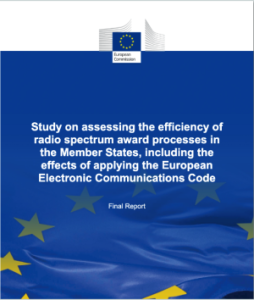European Commission publishes 5G study part-authored by PolicyTracker
We are very pleased to announce the release of a report which we have been working on for the past year as part of a consortium with LS telcom and VVA.
The report examines the effect of spectrum awards on 5G rollout and it was a great privilege to be given so much time to objectively consider a wide range of evidence in this hotly contested area.
Some argue that high auction prices inhibit rollout, for others the debt incentivises it. Does payment by instalments lead to better coverage? Are some auction types more effective? Rather than just measuring coverage, is there a connection between these factors and QoS issues like download speeds? Do the prices charged to consumers play a role? What about the level of market competition?
Having compared all these indicators to the level of rollout there was only one statistically significant correlation: early assignment of the 700 MHz, 3.6 GHz and 26 GHz pioneer bandsThe 5G pioneer bands are a set of spectrum… was associated with better 5G coverage. EU spectrum coordination is a great example of an inexpensive policy initiative which adds huge economic value. (It is time-consuming though!)
One fascinating aspect of this project was the likely impact of extraneous factors or “noise”. For example, the impact of COVID and the semiconductor shortage has probably slowed down all 5G deployment. If high auction prices have an impact, this could have masked it.
The Commission has provided a good summary of the study and it can be read in its entirety here but I want to highlight something which particularly interested me. From a spectrum perspective, the key EU connectivity target is 5G coverage in all populated areas, as set out in the “digital decade” strategy.
Our report recommends greater clarity on what we mean by “coverage”. Is it using the sub-1 GHz bands where the 5G experience is very similar to 4G? Or is it in the higher bands like 3.6 GHz where there is a step change in speeds and latency compared to earlier mobile generations? Ubiquitous coverage in the lower bands is not a game-changer and in the higher bands, it is prohibitively expensive (more detail here on p17).
So what is the middle position which brings clear economic benefits at an affordable price? This is a question occupying minds not just in the EU, but in many other countries too.

